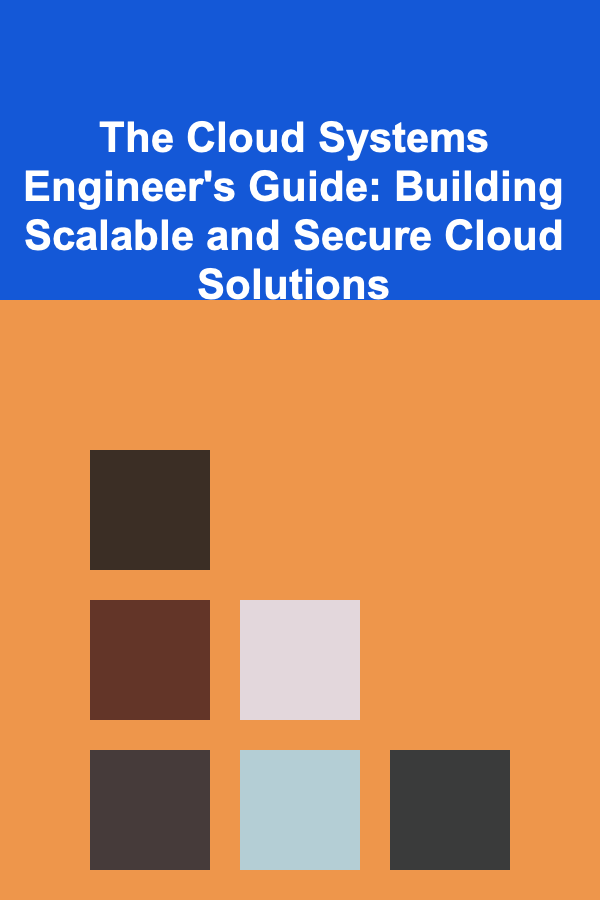
The Cloud Systems Engineer's Guide: Building Scalable and Secure Cloud Solutions
ebook include PDF & Audio bundle (Micro Guide)
$12.99$11.99
Limited Time Offer! Order within the next:

Cloud computing has revolutionized the way businesses deploy, manage, and scale their infrastructure. As organizations increasingly rely on cloud services to manage their operations, the role of the Cloud Systems Engineer has become pivotal in ensuring that cloud architectures are both scalable and secure. This actionable guide will explore the key responsibilities of a Cloud Systems Engineer and the best practices for building reliable, secure, and scalable cloud solutions.
Understanding the Role of a Cloud Systems Engineer
A Cloud Systems Engineer is responsible for designing, implementing, and managing cloud infrastructure for an organization. This includes selecting appropriate cloud services, optimizing performance, ensuring security, and managing the scalability of cloud-based applications. Cloud Systems Engineers must work closely with development teams, IT departments, and stakeholders to create environments that are efficient, resilient, and compliant with industry standards.
Key Responsibilities:
- Cloud Architecture Design: Designing cloud solutions that are optimized for performance, cost-efficiency, and scalability.
- Infrastructure Automation: Automating the deployment and management of cloud infrastructure using tools like Terraform, CloudFormation, or Ansible.
- Security Management: Implementing security best practices, including identity management, encryption, and compliance with data privacy regulations.
- Monitoring and Performance Optimization: Continuously monitoring cloud resources and ensuring that applications perform optimally, scaling up or down based on demand.
- Disaster Recovery and Backup: Designing and implementing disaster recovery strategies to ensure high availability and business continuity.
In the following sections, we will dive deep into how Cloud Systems Engineers can achieve the goals of building scalable and secure cloud solutions.
Building Scalable Cloud Solutions
Scalability is one of the primary advantages of cloud computing, enabling businesses to grow without worrying about hardware limitations. Cloud solutions must be designed to automatically adjust resources based on demand, ensuring that performance remains consistent regardless of traffic fluctuations.
1. Leveraging Auto-Scaling
One of the core principles behind scalable cloud infrastructure is auto-scaling. Auto-scaling refers to the ability of a cloud system to automatically adjust its resources, such as compute instances, storage, or network throughput, based on traffic or workload demands. Popular cloud platforms like AWS, Google Cloud, and Azure provide auto-scaling features that can dynamically scale resources in and out.
Actionable Steps:
- Configure Auto-Scaling Groups: In AWS, use EC2 Auto Scaling groups to automatically increase or decrease the number of instances based on predefined metrics like CPU utilization or network traffic.
- Set Up Load Balancers: Utilize load balancers like AWS Elastic Load Balancing (ELB) or Azure Load Balancer to distribute incoming traffic across multiple instances. This ensures that no single server becomes a bottleneck during traffic spikes.
- Optimize Instance Types: Choose instance types based on the expected workload. For example, compute-optimized instances for CPU-intensive applications or memory-optimized instances for memory-heavy workloads.
2. Containerization and Orchestration
Containerization, along with orchestration tools like Kubernetes, offers a powerful method for scaling cloud applications. Containers allow applications and services to be packaged with all their dependencies and run consistently across different environments, making them ideal for scalable cloud architectures.
Actionable Steps:
- Use Docker for Containerization: Package applications in Docker containers, ensuring that they are portable and can run anywhere. Docker images can be deployed across multiple cloud environments without modification.
- Implement Kubernetes for Orchestration: Kubernetes (often abbreviated as K8s) provides automated container deployment, scaling, and management. It allows applications to be broken down into microservices, each of which can be scaled independently based on demand.
- Leverage Managed Kubernetes Services: Use managed Kubernetes services, such as Amazon EKS, Google Kubernetes Engine (GKE), or Azure Kubernetes Service (AKS), to simplify the deployment and management of Kubernetes clusters.
3. Decoupling Services
Decoupling services is a fundamental principle of building scalable systems. In a monolithic architecture, all components are tightly interconnected, making it difficult to scale specific parts of the application. Microservices architecture, in contrast, enables each component to function independently, scaling individual services based on their needs.
Actionable Steps:
- Design Microservices: Break down the application into independent microservices. For example, one microservice could handle user authentication, while another handles payment processing.
- Use Message Queues: Implement message queues (e.g., AWS SQS, RabbitMQ) to facilitate communication between microservices asynchronously. This decouples services and enables them to scale independently without direct dependencies.
Ensuring Cloud Security
Security is one of the most critical concerns when designing cloud solutions. Given the shared responsibility model of cloud providers, Cloud Systems Engineers need to implement comprehensive security strategies that protect data, prevent unauthorized access, and ensure compliance with regulations.
1. Identity and Access Management (IAM)
Identity and Access Management (IAM) is a fundamental aspect of cloud security. By carefully controlling who can access cloud resources, engineers can mitigate the risk of unauthorized access.
Actionable Steps:
- Create IAM Policies: Use IAM policies to define fine-grained access control, ensuring that users and services only have access to the resources they need. Apply the principle of least privilege, granting only the minimum permissions required.
- Use Multi-Factor Authentication (MFA): Enable MFA to add an extra layer of security for users accessing cloud resources.
- Leverage Federated Identity: Integrate with identity providers (e.g., Active Directory, Google Identity) to simplify user authentication and streamline access management.
2. Data Encryption and Privacy
Data security extends to both data in transit and data at rest. Cloud systems should always use encryption to protect sensitive information from unauthorized access, whether it's stored on disk or being transmitted over the network.
Actionable Steps:
- Encrypt Data at Rest: Use encryption services provided by cloud providers (e.g., AWS KMS, Azure Key Vault) to encrypt data stored in databases, object storage, or file systems.
- Encrypt Data in Transit: Use HTTPS or TLS for securing data transmitted between clients and servers to protect it from interception.
- Implement Key Management: Use a centralized key management system to securely manage encryption keys and rotate them periodically to ensure continued security.
3. Security Audits and Compliance
Ensuring that the cloud infrastructure meets industry security standards and regulatory compliance requirements is crucial for many businesses, especially those in industries like finance or healthcare.
Actionable Steps:
- Enable Logging and Monitoring: Use tools like AWS CloudTrail, Azure Monitor, or Google Cloud's Stackdriver to log all user activities and monitor the security status of cloud resources.
- Regular Security Audits: Conduct regular security audits to assess the effectiveness of existing security controls. Implement penetration testing and vulnerability scanning to identify potential weaknesses.
- Comply with Standards: Ensure that your cloud environment complies with relevant standards and regulations, such as GDPR, HIPAA, or SOC 2. Cloud providers typically offer compliance certifications, but it's essential to ensure your configurations adhere to these standards.
4. Network Security
Network security in the cloud is often more complex due to the dynamic nature of cloud environments. Cloud networks should be segmented and protected to prevent unauthorized access.
Actionable Steps:
- Use Virtual Private Clouds (VPCs): Isolate resources within a VPC to ensure that only authorized traffic can access specific resources. Implement subnetting to create network segments for different services.
- Implement Network Access Control Lists (NACLs): Use NACLs to define rules for inbound and outbound traffic at the subnet level.
- Use Security Groups and Firewalls: Leverage security groups (AWS), network security groups (Azure), or firewall rules to control traffic to and from specific cloud resources.
Optimizing Cloud Performance
While scalability is important, ensuring that cloud applications perform efficiently is equally critical. Cloud performance optimization requires continuous monitoring, tuning, and cost management.
1. Performance Monitoring
Constantly monitoring cloud resources helps identify performance bottlenecks and ensures that applications are functioning as expected. Performance monitoring also helps to anticipate resource demands and adjust accordingly.
Actionable Steps:
- Use Cloud Monitoring Tools: Leverage native cloud monitoring services like AWS CloudWatch, Azure Monitor, or Google Cloud Operations Suite to track metrics such as CPU utilization, memory usage, and network throughput.
- Set Alerts and Notifications: Configure alerts to notify administrators when a resource reaches a certain threshold. This allows for proactive intervention to prevent service degradation.
2. Cost Management
Cloud cost optimization is essential for businesses to manage and reduce their cloud expenditures. Proper resource allocation, scaling strategies, and understanding pricing models help optimize cloud costs.
Actionable Steps:
- Implement Resource Tagging: Tag cloud resources to track usage and costs by department, project, or environment. This makes it easier to allocate costs accurately and spot areas for cost reduction.
- Optimize Reserved Instances: For predictable workloads, use reserved instances (e.g., AWS Reserved EC2 Instances) to reduce costs compared to on-demand pricing.
- Scale Resources Appropriately: Avoid over-provisioning by ensuring that cloud resources are scaled according to real-time demand and that unused resources are decommissioned.
Conclusion
Building scalable and secure cloud solutions is no small feat. Cloud Systems Engineers must carefully design architectures that can scale with demand, secure cloud resources from threats, and optimize performance for a seamless user experience. By leveraging tools for automation, security, and monitoring, engineers can ensure that cloud environments remain efficient, resilient, and secure. As cloud technologies continue to evolve, Cloud Systems Engineers must stay updated on best practices and emerging trends, always striving to improve and adapt their solutions. The key to success in cloud engineering lies in a solid understanding of the cloud ecosystem, continuous learning, and a commitment to building reliable, secure, and scalable systems.
Reading More From Our Other Websites
- [Personal Investment 101] Monetize Your Deep Learning Skills: Top Passive Income Ideas
- [Home Storage Solution 101] How to Create a Hidden Storage Space in Your Living Room
- [Personal Financial Planning 101] How to Save for a Home Down Payment in 5 Years
- [Organization Tip 101] How to Reorganize Your Living Room After a Move
- [Trail Running Tip 101] Cold-Weather Conditioning: Building Strength and Endurance for Snow Trail Running
- [Home Lighting 101] How to Light a Large Room Without Overwhelming the Space
- [Home Budget 101] How to Create a Sustainable Home Budget for Long-Term Savings
- [Home Party Planning 101] How to Plan a Formal Dinner Party in Your Own Home
- [Organization Tip 101] The Best Grout Cleaning Tools for a Sparkling Clean Home
- [Home Soundproofing 101] How to Soundproof a Basement for a Peaceful Environment

How To Create a "Freedom Fund" for Your Goals
Read More
How to Organize Your Pantry for Easy Access
Read More
How to Start a Home-Based Real Estate Business with Little Investment
Read More
How to Style Co-Ord Sets for Effortless Chic
Read More
How To Understand Different Backpacking Food Options
Read More
How to Explore Precision Diagnostics for Rare Diseases
Read MoreOther Products

How To Create a "Freedom Fund" for Your Goals
Read More
How to Organize Your Pantry for Easy Access
Read More
How to Start a Home-Based Real Estate Business with Little Investment
Read More
How to Style Co-Ord Sets for Effortless Chic
Read More
How To Understand Different Backpacking Food Options
Read More